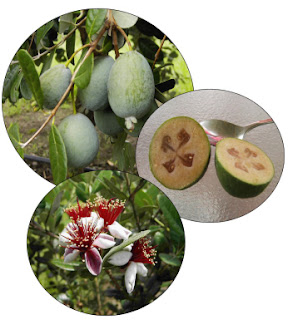I have only noticed and tried feijoa, also known as 'pineapple guava' recently.
Up until this year, it has never caught my eye. Last year, we started shopping at a particular market and they always stock seasonal fresh produce that are organically or biodynamically grown. When feijoa was on display about a month ago, it caught my attention and I asked the very knowledgeable and helpful shop assistant there a few questions about this particular fruit. He is passionate about what he does, I believe. He was happily involved in the conversation and when he didn't know the answer to one of my questions which was not necessarily a very important one but I was curious about it, he quickly went inside, brought a book with him and found the relevant page easily. It was a very informative and enjoyable little chat that him, his co-worker who joined us a little later and I had that day.
From that conversation, his book and also from other sources, I was able to gather some useful information for us all. Here is the brief conclusion of my findings for you:
Feijoa fruit originates from South America but is also well known and locally grown in New Zealand too. Its types vary. It is egg shaped. It has a distinctive smell and is sweet in taste.
To eat, simply, cut the fruit up in half and scoop out the juicy flesh. Usually, you can just pinch the end and majority of the fruit comes right out. Some people don't even peel it and eat the skin too but it is a bit bitter and I do not recommend eating it. If preferred, you can make jelly, chutney and jam with feijoa, or put it in cakes, icecreams, puddings and drinks as flavouring.
If overmature, it will look bruised and go brown on the inside. If so, it should not be eaten.
Health benefits:
Feijoa has great antioxidant activity (containing proanthoncyanins). It is high in vitamin C, minerals and fiber. It is low in calorie.
Enjoy something new today!




No comments:
Post a Comment
I love comments. Thank you for leaving one!